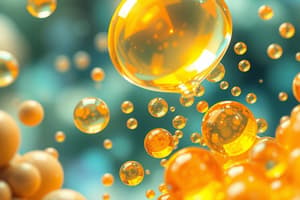Podcast
Questions and Answers
What effect does reducing the particle size of griseofulvin have on its solubility and dissolution rate?
What effect does reducing the particle size of griseofulvin have on its solubility and dissolution rate?
- Increases solubility and dissolution rate (correct)
- Has no impact on solubility and dissolution rate
- Reduces solubility but increases dissolution rate
- Decreases solubility and dissolution rate
Why is it important to optimize the particle size of dispersed phases in cosmetic cream formulations?
Why is it important to optimize the particle size of dispersed phases in cosmetic cream formulations?
- To achieve the desired sensory attributes (correct)
- To increase particle interlocking
- To enhance flowability of the cream
- To ensure a gritty texture
Which type of particles tend to pack more closely and have less air space between them, affecting flowability?
Which type of particles tend to pack more closely and have less air space between them, affecting flowability?
- Irregular or angular particles
- Spherical or smooth particles
- Denser particles (correct)
- Less dense particles
How can electrostatic charge affect the flowability of a material?
How can electrostatic charge affect the flowability of a material?
What is the role of moisture in powder flowability?
What is the role of moisture in powder flowability?
What happens to cement's flowability when it is hydrated?
What happens to cement's flowability when it is hydrated?
How does particle size affect the solubility and dissolution rate of a drug?
How does particle size affect the solubility and dissolution rate of a drug?
What technique can be employed to reduce the particle size of a drug?
What technique can be employed to reduce the particle size of a drug?
Why does reducing the particle size of griseofulvin enhance its solubility and dissolution rate?
Why does reducing the particle size of griseofulvin enhance its solubility and dissolution rate?
What is a drawback of smaller particles compared to larger particles in terms of stability?
What is a drawback of smaller particles compared to larger particles in terms of stability?
How does reducing particle size affect the flowability of a drug?
How does reducing particle size affect the flowability of a drug?
Which drug is provided as an example in the text that is affected by particle size?
Which drug is provided as an example in the text that is affected by particle size?
Flashcards are hidden until you start studying
Study Notes
Poorly Water-Soluble Drug Formulation
- Larger particle size is associated with poor dissolution and reduced bioavailability of a drug.
- Smaller particles have higher solubility and dissolution rates due to increased surface area.
- Techniques like micronization or nanosizing can be used to reduce particle size and enhance dissolution rates.
- Example of a drug affected by particle size is griseofulvin, which has low solubility and dissolution rate, but reducing its particle size increases its surface area, enhancing solubility and dissolution rate.
- Smaller particles have lower stability due to increased susceptibility to aggregation, oxidation, or degradation.
- Smaller particles may have better flowability due to their ability to slide past each other more easily.
Cosmetic Cream Formulation
- Particle size of dispersed phases in emulsions affects the sensory attributes of creams and lotions.
- Larger particles can result in a gritty or unpleasant texture.
- Optimizing particle size of emulsifying agents and active ingredients ensures a smooth and aesthetically pleasing product.
Particle Flowability
- Flowability is the ability of a solid material to move or flow smoothly and easily.
- Particle size, shape, density, surface area, moisture content, electrostatic charge, and interparticle interactions affect flowability.
- Irregular or angular particles have lower flowability due to interlocking, whereas spherical or smooth particles have higher flowability.
- Denser particles have lower flowability due to less air space, while less dense particles have higher flowability.
- Electrostatic charge and interparticle interactions, such as van der Waals forces or chemical bonds, affect the cohesion and flowability of the material.
- Moisture can act as a binder or lubricant between particles, affecting flowability.
Studying That Suits You
Use AI to generate personalized quizzes and flashcards to suit your learning preferences.




